Development, Advantages, Disadvantages, Usage of Railway Sleepers
Aug 05, 2021
The railway sleepers must not only support the rail, but also maintain the position of the rail, and transfer the huge pressure from the rail to the track bed. It must have a certain degree of flexibility and elasticity. When the train passes, it can be deformed appropriately to cushion the pressure, but after the train passes, it must be restored as much as possible.
The types of railway sleepers include: wooden sleepers, reinforced concrete sleepers, plastic sleepers, concrete sleepers, special concrete sleepers, steel sleepers, synthetic sleepers.
The railway sleeper was originally made of wood. The wood has good elasticity and insulation, is less affected by the temperature change of the surrounding medium, is light in weight, easy to process and replace on the line, and has sufficient displacement resistance. The service life of the anti-corrosive wooden sleeper is also greatly extended, about 15 years. Therefore, 90% of the railways in the world use wooden sleepers.
According to statistics, during the peak use period of wooden sleepers, more than 3 billion pine trees were laid all over the world. As you can imagine, how much forest has to be destroyed?
With the decrease of forest resources and the increase of people's awareness of environmental protection, of course also because of the development of science and technology, some countries began to produce steel sleepers and reinforced concrete sleepers in the beginning of the last century to replace sleepers. However, because steel sleepers consume too much metal, they are expensive and bulky, they have not been promoted, and only a few countries such as Germany are still using them. Many countries have generally produced reinforced concrete sleepers since the 1950s.
1. Wooden Sleeper(Timber Sleeper)
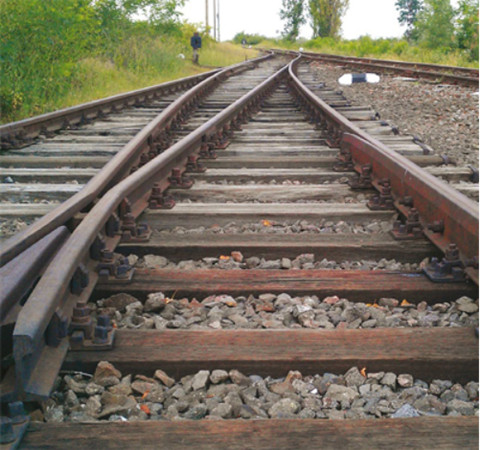
The railway sleeper was originally made of wood. The wood has good elasticity and insulation, is less affected by the temperature change of the surrounding medium, is light in weight, easy to process and replace on the line, and has sufficient displacement resistance. The service life of the anti-corrosive wooden sleeper is also greatly extended, about 15 years. Therefore, 90% of the railways in the world use wooden sleepers.
According to statistics, during the peak use period of wooden sleepers, more than 3 billion pine trees were laid all over the world. As you can imagine, how much forest has to be destroyed?
With the decrease of forest resources and the increase of people's awareness of environmental protection, of course also because of the development of science and technology, some countries began to produce steel sleepers and reinforced concrete sleepers in the beginning of the last century to replace sleepers. However, because steel sleepers consume too much metal, they are expensive and bulky, they have not been promoted, and only a few countries such as Germany are still using them. Many countries have generally produced reinforced concrete sleepers since the 1950s.
2. Reinforced concrete sleepers
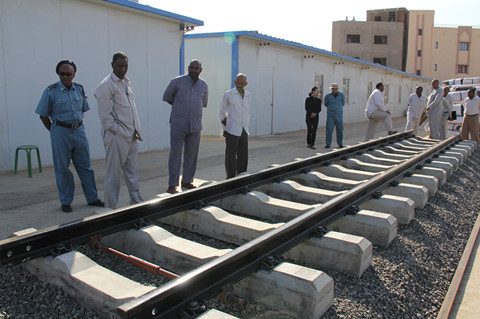
Long service life, high stability, small maintenance workload, and much lower damage rate and scrap rate than wooden sleepers. On the seamless track, the stability of reinforced concrete sleepers is 15-20% higher than that of wooden sleepers on average, so it is especially suitable for high-speed passenger lines. For example, Japan’s Shinkansen and Russia’s high-speed trunk lines are all laid.
Of course, reinforced concrete sleepers also have disadvantages, especially their weight is much heavier than wooden sleepers. For example, the weight of reinforced concrete sleepers in the United Kingdom is 285 kilograms, the weight of the United States is 280 kilograms, and the lighter ones in Germany are 230 kilograms.
Therefore, it is not suitable for use in unstable roadbeds and newly filled roadbeds; in winter areas with frost heave, it is generally not allowed; in areas where a large amount of coal and ore are transported and the track bed is seriously dirty, it is best not to use it.
3.Plastic Sleeper
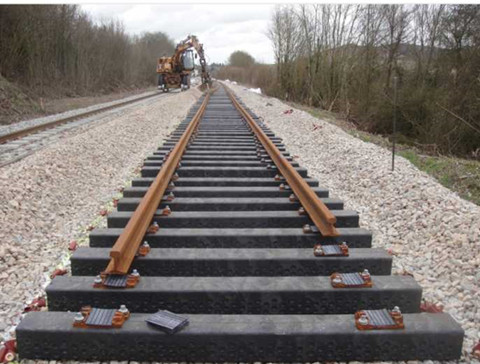
The United States, which used the most wooden sleepers, now uses a plastic sleeper. This kind of plastic sleeper made of recycled polyethylene is more than 3 times more corrosion resistant than wooden sleepers, and it is easier to make the surface "fuzzy" during processing, and it will not slide when installed on the roadbed. The third advantage is that it is easy to install and can directly use the same equipment and fasteners as wooden sleepers. Of course, the cost of plastic sleepers is higher than that of wooden sleepers. Once the cost is lowered, it will be quickly promoted.
The sleepers have different lengths due to different application areas. In China, the length of ordinary sleepers is 2.5m, and the lengths of turnout sleepers and steel bridge sleepers are 2.6~4.85m. The number of sleepers laid per kilometer is determined according to operating conditions such as railway traffic volume and driving speed. Generally speaking, it is between 1520 and 1840. It goes without saying that the greater the number of sleepers, the greater the track strength.
4. Concrete sleepers
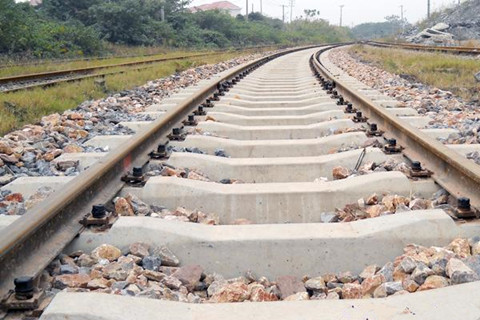
After the Second World War, countries around the world gradually used reinforced concrete sleepers due to the shortage of timber resources; later improved into prestressed concrete sleepers. Chinese railways have also adopted a large number of prestressed concrete sleepers since 1957. As of the end of 1983, approximately 64.45 million had been laid. In 1983, the annual output was more than 4 million pieces, which accounted for about a quarter of the world's annual output of prestressed concrete sleepers (about 15 million pieces). Prestressed sleeper force concrete sleepers can not only save a lot of high-quality steel, but also have the advantages of long service life, good track stability, and can meet the requirements of high speed and large transportation volume. Played a great role in the promotion of seamless lines.
Its disadvantages are high rigidity and poor elasticity, which increases the pressure and vibration acceleration of the track bed, which intensifies the pulverization of the ballast, increases the sinking of the track, and adversely affects the running part of the rolling stock. For this reason, it is required to use tough ballast and set up an elastic cushion on the sleeper.
The structure of concrete sleepers in railways in different countries is different, most of which are continuous and whole. Railways in some countries adopt a structure in which two pieces of concrete supporting the rails are connected with section steel.
In addition, many countries also pay attention to improving the performance of fasteners. China's ω-type spring-type fasteners, the British Pandrol-type fasteners and the Swiss Fist-type fasteners are all designed and manufactured for this purpose.
5. Special concrete sleepers
.jpg)
The special concrete sleeper includes wide concrete sleepers and steel fiber concrete sleepers. The wide concrete sleeper is made of reinforced concrete, which looks like a concrete sleeper, but is wider and thinner than the concrete sleeper. It is also called sleeper slab. The concrete wide pillows are neat and beautiful in appearance, generally 2.5m long and 55-60cm wide. They are laid in close rows on a compacted clean gravel bed.
There are 1760 wide concrete sleepers laid per kilometer, and a pair of fasteners are installed on each wide sleeper. The load transmitted from the rails has a small eccentricity and good stability for the wide sleepers. Due to the large supporting area, compared with concrete sleepers, the amount of track subsidence is significantly reduced, which can slow down the accumulation of permanent deformation of the track bed, smooth the line, and reduce the maintenance workload.
Because the elasticity, section size, drainage method and other aspects of the concrete wide sleeper track are different from those of other structural forms, it is necessary to set a transition section when connecting with other tracks to make it uniformly change.
Steel fiber concrete sleepers refer to concrete sleepers made of concrete mixed with a certain amount of steel fibers. Steel fiber concrete is a new type of composite material that increases strength and toughness. Steel fiber concrete sleepers can improve the sleeper’s impact toughness, crack resistance, tensile strength, shear resistance, bending resistance, and fatigue resistance to extend the life of the sleeper. It is suitable for small radius curves and joints, and can better solve nail holes. Problems such as longitudinal cracks and damage to the retaining shoulder.
6. Steel sleepers
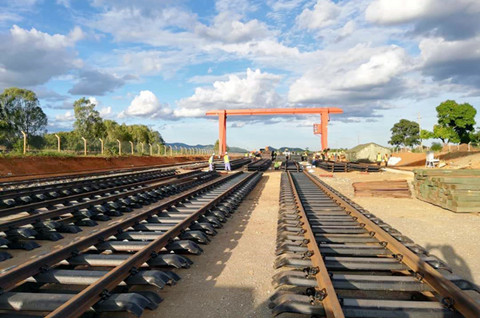
On the railways of the Federal Republic of Germany and Switzerland, steel sleepers have been widely used. However, because the steel sleepers are easy to corrosion, the demand for the amount of steel is large, the maintenance cost is high, and the amount of use is gradually reduced.
7.Synthetic Sleepers(Composite Sleepers)
.jpg)
Synthetic sleeper, also known as a composite sleeper, made of a composite material sheet produced by a foam extrusion process with continuous glass fiber as a reinforcing material(Fiber-reinforced Foamed Urethane), polyurethane as a matrix material, supplemented with additives. It has higher strength and widely used as a structural material, besides, it is light in weight(about 80% less weight than concrete sleepers), insulating and resistant to aging, heat-insulating, chemical-resistant,50 years of maintenance-free, low overall life cycle cost, etc.
The types of railway sleepers include: wooden sleepers, reinforced concrete sleepers, plastic sleepers, concrete sleepers, special concrete sleepers, steel sleepers, synthetic sleepers.
The railway sleeper was originally made of wood. The wood has good elasticity and insulation, is less affected by the temperature change of the surrounding medium, is light in weight, easy to process and replace on the line, and has sufficient displacement resistance. The service life of the anti-corrosive wooden sleeper is also greatly extended, about 15 years. Therefore, 90% of the railways in the world use wooden sleepers.
According to statistics, during the peak use period of wooden sleepers, more than 3 billion pine trees were laid all over the world. As you can imagine, how much forest has to be destroyed?
With the decrease of forest resources and the increase of people's awareness of environmental protection, of course also because of the development of science and technology, some countries began to produce steel sleepers and reinforced concrete sleepers in the beginning of the last century to replace sleepers. However, because steel sleepers consume too much metal, they are expensive and bulky, they have not been promoted, and only a few countries such as Germany are still using them. Many countries have generally produced reinforced concrete sleepers since the 1950s.
1. Wooden Sleeper(Timber Sleeper)

The railway sleeper was originally made of wood. The wood has good elasticity and insulation, is less affected by the temperature change of the surrounding medium, is light in weight, easy to process and replace on the line, and has sufficient displacement resistance. The service life of the anti-corrosive wooden sleeper is also greatly extended, about 15 years. Therefore, 90% of the railways in the world use wooden sleepers.
According to statistics, during the peak use period of wooden sleepers, more than 3 billion pine trees were laid all over the world. As you can imagine, how much forest has to be destroyed?
With the decrease of forest resources and the increase of people's awareness of environmental protection, of course also because of the development of science and technology, some countries began to produce steel sleepers and reinforced concrete sleepers in the beginning of the last century to replace sleepers. However, because steel sleepers consume too much metal, they are expensive and bulky, they have not been promoted, and only a few countries such as Germany are still using them. Many countries have generally produced reinforced concrete sleepers since the 1950s.
2. Reinforced concrete sleepers

Long service life, high stability, small maintenance workload, and much lower damage rate and scrap rate than wooden sleepers. On the seamless track, the stability of reinforced concrete sleepers is 15-20% higher than that of wooden sleepers on average, so it is especially suitable for high-speed passenger lines. For example, Japan’s Shinkansen and Russia’s high-speed trunk lines are all laid.
Of course, reinforced concrete sleepers also have disadvantages, especially their weight is much heavier than wooden sleepers. For example, the weight of reinforced concrete sleepers in the United Kingdom is 285 kilograms, the weight of the United States is 280 kilograms, and the lighter ones in Germany are 230 kilograms.
Therefore, it is not suitable for use in unstable roadbeds and newly filled roadbeds; in winter areas with frost heave, it is generally not allowed; in areas where a large amount of coal and ore are transported and the track bed is seriously dirty, it is best not to use it.
3.Plastic Sleeper

The United States, which used the most wooden sleepers, now uses a plastic sleeper. This kind of plastic sleeper made of recycled polyethylene is more than 3 times more corrosion resistant than wooden sleepers, and it is easier to make the surface "fuzzy" during processing, and it will not slide when installed on the roadbed. The third advantage is that it is easy to install and can directly use the same equipment and fasteners as wooden sleepers. Of course, the cost of plastic sleepers is higher than that of wooden sleepers. Once the cost is lowered, it will be quickly promoted.
The sleepers have different lengths due to different application areas. In China, the length of ordinary sleepers is 2.5m, and the lengths of turnout sleepers and steel bridge sleepers are 2.6~4.85m. The number of sleepers laid per kilometer is determined according to operating conditions such as railway traffic volume and driving speed. Generally speaking, it is between 1520 and 1840. It goes without saying that the greater the number of sleepers, the greater the track strength.
4. Concrete sleepers

After the Second World War, countries around the world gradually used reinforced concrete sleepers due to the shortage of timber resources; later improved into prestressed concrete sleepers. Chinese railways have also adopted a large number of prestressed concrete sleepers since 1957. As of the end of 1983, approximately 64.45 million had been laid. In 1983, the annual output was more than 4 million pieces, which accounted for about a quarter of the world's annual output of prestressed concrete sleepers (about 15 million pieces). Prestressed sleeper force concrete sleepers can not only save a lot of high-quality steel, but also have the advantages of long service life, good track stability, and can meet the requirements of high speed and large transportation volume. Played a great role in the promotion of seamless lines.
Its disadvantages are high rigidity and poor elasticity, which increases the pressure and vibration acceleration of the track bed, which intensifies the pulverization of the ballast, increases the sinking of the track, and adversely affects the running part of the rolling stock. For this reason, it is required to use tough ballast and set up an elastic cushion on the sleeper.
The structure of concrete sleepers in railways in different countries is different, most of which are continuous and whole. Railways in some countries adopt a structure in which two pieces of concrete supporting the rails are connected with section steel.
In addition, many countries also pay attention to improving the performance of fasteners. China's ω-type spring-type fasteners, the British Pandrol-type fasteners and the Swiss Fist-type fasteners are all designed and manufactured for this purpose.
5. Special concrete sleepers
.jpg)
The special concrete sleeper includes wide concrete sleepers and steel fiber concrete sleepers. The wide concrete sleeper is made of reinforced concrete, which looks like a concrete sleeper, but is wider and thinner than the concrete sleeper. It is also called sleeper slab. The concrete wide pillows are neat and beautiful in appearance, generally 2.5m long and 55-60cm wide. They are laid in close rows on a compacted clean gravel bed.
There are 1760 wide concrete sleepers laid per kilometer, and a pair of fasteners are installed on each wide sleeper. The load transmitted from the rails has a small eccentricity and good stability for the wide sleepers. Due to the large supporting area, compared with concrete sleepers, the amount of track subsidence is significantly reduced, which can slow down the accumulation of permanent deformation of the track bed, smooth the line, and reduce the maintenance workload.
Because the elasticity, section size, drainage method and other aspects of the concrete wide sleeper track are different from those of other structural forms, it is necessary to set a transition section when connecting with other tracks to make it uniformly change.
Steel fiber concrete sleepers refer to concrete sleepers made of concrete mixed with a certain amount of steel fibers. Steel fiber concrete is a new type of composite material that increases strength and toughness. Steel fiber concrete sleepers can improve the sleeper’s impact toughness, crack resistance, tensile strength, shear resistance, bending resistance, and fatigue resistance to extend the life of the sleeper. It is suitable for small radius curves and joints, and can better solve nail holes. Problems such as longitudinal cracks and damage to the retaining shoulder.
6. Steel sleepers

On the railways of the Federal Republic of Germany and Switzerland, steel sleepers have been widely used. However, because the steel sleepers are easy to corrosion, the demand for the amount of steel is large, the maintenance cost is high, and the amount of use is gradually reduced.
7.Synthetic Sleepers(Composite Sleepers)
.jpg)
Synthetic sleeper, also known as a composite sleeper, made of a composite material sheet produced by a foam extrusion process with continuous glass fiber as a reinforcing material(Fiber-reinforced Foamed Urethane), polyurethane as a matrix material, supplemented with additives. It has higher strength and widely used as a structural material, besides, it is light in weight(about 80% less weight than concrete sleepers), insulating and resistant to aging, heat-insulating, chemical-resistant,50 years of maintenance-free, low overall life cycle cost, etc.

